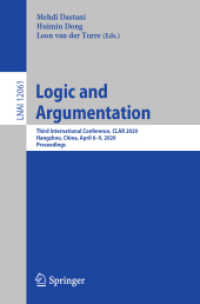- ホーム
- > 洋書
- > 英文書
- > Computer / General
Full Description
The book discusses the foundations of intelligent quantum information processing applied to several real-life engineering problems, including intelligent quantum systems, intelligent quantum communication, intelligent process optimization, and intelligent quantum distributed networks.
This book:
• Showcases a detailed overview of different quantum machine learning algorithmic frameworks.
• Presents real-life case studies and applications.
• Provides an in-depth analysis of quantum mechanical principles.
• Provides a step-by-step guide in the build-up of quantum inspired/quantum intelligent information processing systems.
• Provides a video demonstration on each chapter for better understanding.
It will serve as an ideal reference text for graduate students and academic researchers in fields such as electrical engineering, electronics and communication engineering, computer engineering, and information technology.
Contents
Preface
About the Editors
List of Contributors
1 The Role of Quantum Entanglement in Information Processing for Secured Data Transmission
ARPAN DEYASI, PAMPA DEBNATH, AND SIDDHARTHA BHATTACHARYYA
1.1 Introduction
1.2 Quantum Interference
1.3 Quantum Superposition
1.4 Quantum Entanglement
1.5 Quantum Communication
1.6 Quantum Information Processing
1.7 Qubit
1.8 Secured Data Communication
1.9 Quantum Key Distribution
1.10 Quantum Internet
References
2 Quantum Information Processing for Next-Generation Communication System Design
SWETA SHARMA, SOUMEN SANTRA, AND ARPAN DEYASI
2.1 Introduction
2.1.1 Historical Development of Quantum Information Science
2.2 Quantum Algorithm
2.2.1 Algorithms Based on the Quantum Fourier Transform
2.2.2 Algorithms Based on Amplitude Amplification
2.2.3 Algorithms Based on Quantum Walks
2.2.4 BQP-Complete Problems
2.2.5 Hybrid Quantum/Classical Algorithms
2.3 Recent Advances and Current Prospects in Quantum Information Processing
2.3.1 Quantum Computation
2.3.2 Theory of Quantum Computation
2.3.3 Quantum Communication
2.3.4 Quantum Sensing and Metrology
2.4 Conceptual and Technical Challenges
2.4.1 Challenges for Quantum Computing
2.4.2 Challenges for Quantum Communications
2.4.3 Challenges for Quantum Sensing and Metrology
2.5 Conclusion
References
3 Automatic Classification of Tables Using Hybrid Quantum Convolutional Neural Networks
ERICK FRANCO-GAONA, IVÁN CRUZ-ACEVES, AND MARIA-SUSANA AVILA-GARCIA
3.1 Introduction
3.2 Background
3.2.1 Database of Information Elements
3.2.2 Convolutional Neural Networks
3.2.3 Quantum Convolutional Neural Networks
3.3 Proposed Method for Classifying Tables
3.3.1 Hybrid Quantum Convolutional Neural Networks
3.3.2 Convolutional Neural Networks
3.3.3 Transfer Learning
3.3.4 Data Augmentation
3.3.5 Hyperparameters
3.3.6 Evaluation Metrics
3.4 Computational Experiments
3.4.1 CNN Experiments
3.4.2 HQCNN Experiments
3.5 Conclusion and Future Work
3.6 Appendix
References
4 Transformation Optics: Subwavelength Control of Light Leads to Novel Phased Array Antenna System Design
DIPANKAR MITRA, ERIC JAHNS, SHUVASHIS DEY, AND SAYAN ROY
4.1 Introduction
4.2 Form-Invariance of Maxwell's Equations and Its Relevance to TO
4.3 Design of Phased Array Antenna Elements Using TO
4.4 Future Directions of the TO-Based Design: Can Deep Learning Be a Solution?
4.5 Conclusion
Acknowledgment
References
5 Programming Quantum Hardware via Levenberg-Marquardt Machine Learning
JAMES E. STECK, NATHAN L. THOMPSON, AND ELIZABETH C. BEHRMAN
5.1 Introduction
5.2 Machine Learning for Deep Time Quantum Networks
5.2.1 Machine Learning in Simulation
5.2.2 A Hardware-Compatible Model for IBM Qiskit
5.3 Finite Difference Gradient Descent Learning on Quantum Hardware
5.3.1 Fourier Quantum Parameters for Simulations
5.3.2 Parameter Variation Finite Difference Gradients' Learning Results
5.3.3 Finite Difference Gradient Descent Learning on IBM Qiskit
5.4 Levenberg-Marquardt Learning for Quantum Hardware
5.4.1 Levenberg-Marquardt Algorithm Applied to Quantum Computing
5.4.2 Levenberg-Marquardt Training: MATLAB Simulation Results
5.4.3 Levenberg-Marquardt Qiskit Training Results
5.5 Conclusion
Acknowledgment
References
6 Numerical Modeling of the Major Temporal Arcade Using a Quantum Genetic Algorithm
JOSÉ ALFREDO SOTO-ÁLVAREZ, IVÁN CRUZ-ACEVES, ARTURO HERNÁNDEZ-AGUIRRE, MARTHA ALICIA HERNÁNDEZ-GONZÁLEZ, AND LUIS MIGUEL LÓPEZ-MONTERO
6.1 Introduction
6.2 Background
6.2.1 Database of Major Temporal Arcade Images
6.2.2 Polynomial Fitting
6.2.3 Genetic Algorithms
6.2.4 Quantum Genetic Algorithm
6.2.5 Proposed Method
6.2.6 Evaluation Measures
6.3 Computational Experiments
6.4 Conclusion
6.5 Appendix: Matlab Code
References
7 Quantum Logic Gate-Based Circuit Design for Computing Applications
JOY BHATTACHARJEE AND ARPAN DEYASI
7.1 Introduction
7.2 Quantum Computing
7.2.1 Superposition
7.2.2 Quantum Entanglement
7.2.3 Quantum Tunneling
7.3 Quantum Bit (Qubit)
7.3.1 What Is Qubit?
7.3.2 Formulation of a Qubit
7.4 Logic Gates
7.4.1 Pauli X, Y and Z Gates
7.4.2 Hadamard (H) Gate
7.4.3 R f Gate or RZ Gate
7.5 Multiplexer Using Quantum Bits
7.5.1 Fredkin Gate
7.5.2 Multiplexer
7.6 Conclusion
References
8 Recent Trends and Challenges in Quantum Computing Based on Artificial Intelligence
KRISHNANJAN MUKHERJEE, RATNESWAR GHOSH, AND SOUMEN SANTRA
8.1 Introduction
8.1.1 Literature Survey
8.1.2 Historical Development of Quantum Computing
8.2 Essential Hardware Components of a Quantum Computer
8.2.1 Data Plane of Quantum
8.2.2 Parameters of Plane of Control and Measurement
8.2.3 Processor Plane and Host Control
8.2.4 Qubit Technologies
8.3 Types of Quantum Computer
8.3.1 Quantum Annealer
8.3.2 Analogue Quantum Annealer
8.3.3 Universal Quantum Computer
8.4 Quantum Bits
8.5 Types of Qubits
8.5.1 Qubit: Superconductor
8.5.2 Qubit: Quantum Dot
8.5.3 Qubit: Trapped Ion
8.5.4 Qubit: Photonic
8.5.5 Qubit: Defect-Based
8.5.6 Qubit: Topological
8.5.7 NMR Qubit
8.6 Applications
8.6.1 Artificial Intelligence and Machine Learning
8.6.2 Computation Chemistry
8.6.3 Cybersecurity and Cryptography
8.6.4 Weather Forecasting
8.7 Comparisons of Quantum Computing Applications
8.7.1 Margolus and Toffoli Gates
8.7.2 Deutsch-Jozsa Algorithm
8.7.3 Bernstein-Vazirani Algorithm
8.8 Recent Works
8.8.1 Case Study 1
8.8.2 Case Study 2
8.8.3 Case Study 3
8.8.4 Some of the Recent Works on Quantum Computing
8.9 Future Works and Conclusion
References
9 Quantum Microwave Engineering: A New Application Area of Quantum Computing
PAMPA DEBNATH, ARPAN DEYASI, AND SIDDHARTHA BHATTACHARYYA
9.1 Introduction
9.2 Quantum Microwave Propagation
9.2.1 Guided Propagation
9.2.2 Non-Guided Propagation
9.3 Quantum Computing with Qubits
9.3.1 Qubit Basics
9.3.2 Qubits Operated as Resonators
9.4 Physical Realization of Qubit
9.4.1 Qubit Trapped Ion
9.4.2 Spin Qubits for Semiconductors
9.4.3 Superconducting Qubits
9.5 Conclusion
References
10 Intelligent Quantum Information Processing: Future Directions of Research
PAMPA DEBNATH, ARPAN DEYASI, AND SIDDHARTHA BHATTACHARYYA
10.1 Conclusion
10.2 Future Research Initiatives
References
Index







